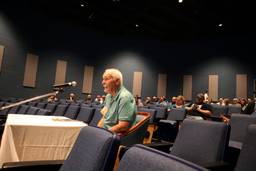When New York cabbie Ahmed Sharif spread his arms before news reporters and displayed the deep wounds running across his neck and arm, the scars seemed like a testament to the hatred that has ripped through the city in recent weeks.
Appearing at a press conference shortly after the assault in his cab, allegedly by a young man hurling anti-Muslim epithets, the 43-year-old Bangladeshi immigrant recalled the traumatic stabbing and said in a fatigued voice that he could only assume, “Of course it was for my religion.”
The attack coincides with exploding ethnic tensions over the proposed Islamic cultural center in Lower Manhattan. Many fear the public backlash against the Park 51 project is whipping up a violent atmosphere of bigotry.
Warning of the violent climate coursing through city streets, Sharif said, “Right now, the public sentiment is very serious… All drivers should be more careful.”
The New York Taxi Workers Alliance, a worker-led advocacy organization, does not discount the apparent anti-Muslim bias in the attack. Yet the group points out that the daily hazards of the job pose a more systemic threat to the livelihoods, and often, the very lives, of cab drivers.
Sharif’s brutal encounter is the latest in a string of violent incidents involving cabbies. In April, another driver, Jangbir Singh, was attacked with a metal pipe and told “go back to your f — ing country.”
The NYTWA framed Sharif’s assault as further vindication of the newly passed Taxi Driver Protection Act, now awaiting Governor Patterson’s signature. The landmark legislation would step up criminal punishment for assaulting cabbies and require warning signs in cabs about the penalties, on par with protections for public transit drivers.
According to the Occupational Safety and Health Administration, from 1998 to 2007, “taxi drivers’ homicide rates were between 21 and 33 times higher than the national average for all workers.” The risk of robbery is also extraordinarily high. The obvious driving factor is constant exposure to mean streets: a typical cabbie may trawl along Broadway for a 12-hour shift, carrying an entire day’s cash earnings, desperate to pick up anyone who flags them down.
The vulnerability of taxi workers, a large portion of whom are of Muslim or South Asian descent, is intensified by a business structure that fuels self-exploitation. While their pay is regulated by the city’s Taxi and Limousine Commission, workers are dubiously classified as “independent contractors” and not standard employees. As a result, they lack organizing rights under federal labor law and, like domestic and farm workers, are categorically excluded from various labor protections.
According to a 2003 report by the NYTWA, the structure of the cab leasing system, to which most cabbies are tied, presents all the burdens associated with ownership and none of the benefits. Following a deregulatory shift in the industry about thirty years ago, drivers “lost access to benefits, such as paid time off, unemployment and health insurance, and their workdays were extended by 15%. Their income on an hourly basis would decline by 23%.”
Today, taxi drivers routinely mount massive debts to lease their medallion and pay other operating costs — a vocation that is tantamount, according to one driver’s testimony, to “a personal and financial hell.”
Ironically, 9/11 — the very phenomenon that unleashed a blast of anti-Muslim hatred around the country — resulted in economic devastation for impacted local drivers. According to the NYTWA’s report, “many drivers were unable to access disaster-related benefits for displaced workers after September 11 due to narrow eligibility guidelines and lack of information,” and of the few drivers who did apply, “34% were denied assistance.”
Noting the intersection of religious bias and economic oppression, Bhairavi Desai, executive director of the Alliance, told In These Times, “we believe that Ahmed was made vulnerable, 1. because he’s a driver and 2. because he’s a Muslim…. But we don’t believe that you can separate the two.”
Cabbies like Sharif found themselves on a dangerous path long before the Ground Zero controversy. His scars represent a cycle of poverty and discrimination that ensnares countless immigrant workers. In solidarity with Sharif, the city’s weariest drivers have embarked on a long, long road to recovery.
Michelle Chen is a contributing writer at In These Times and The Nation, a contributing editor at Dissent and a co-producer of the “Belabored” podcast. She studies history at the CUNY Graduate Center. She tweets at @meeshellchen.








